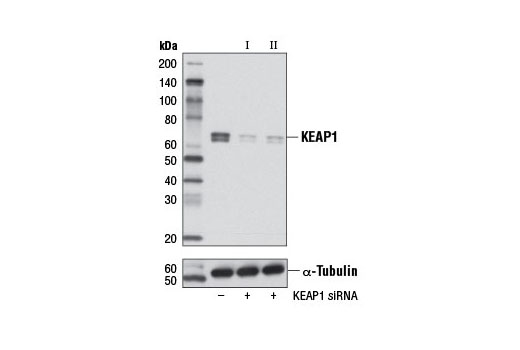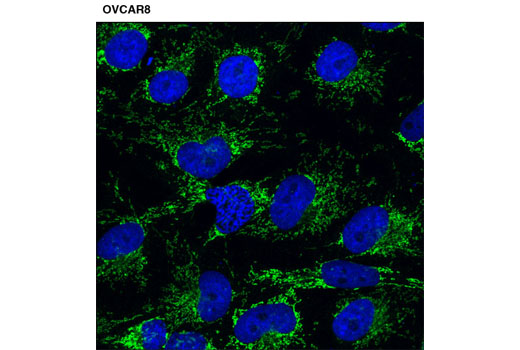WB, IF-IC
H M R
Endogenous
60-64
Rabbit IgG
#Q14145
9817
Product Information
Product Usage Information
| Application | Dilution |
|---|---|
| Western Blotting | 1:1000 |
| Immunofluorescence (Immunocytochemistry) | 1:100 - 1:400 |
Storage
Specificity / Sensitivity
Species Reactivity:
Human, Mouse, Rat
Species predicted to react based on 100% sequence homology
The antigen sequence used to produce this antibody shares
100% sequence homology with the species listed here, but
reactivity has not been tested or confirmed to work by CST.
Use of this product with these species is not covered under
our
Product Performance Guarantee.
Monkey, Bovine, Pig
Source / Purification
Monoclonal antibody is produced by immunizing animals with a synthetic peptide corresponding to residues surrounding Glu593 of human KEAP1 protein.
Background
The nuclear factor-like 2 (NRF2) transcriptional activator binds antioxidant response elements (ARE) of target gene promoter regions to regulate expression of oxidative stress response genes. Under basal conditions, the NRF2 inhibitor INrf2 (also called KEAP1) binds and retains NRF2 in the cytoplasm where it can be targeted for ubiquitin-mediated degradation (1). Small amounts of constitutive nuclear NRF2 maintain cellular homeostasis through regulation of basal expression of antioxidant response genes. Following oxidative or electrophilic stress, KEAP1 releases NRF2, thereby allowing the activator to translocate to the nucleus and bind to ARE-containing genes (2). The coordinated action of NRF2 and other transcription factors mediates the response to oxidative stress (3). Altered expression of NRF2 is associated with chronic obstructive pulmonary disease (COPD) (4). NRF2 activity in lung cancer cell lines directly correlates with cell proliferation rates, and inhibition of NRF2 expression by siRNA enhances anti-cancer drug-induced apoptosis (5).
KEAP1 contains an amino terminal BTB/POZ domain and a carboxyl terminal KELCH domain (6,7). The KELCH domain is required for interaction with NRF2, and the BTB/POZ domain functions in binding Cul3 E3 ubiquitin ligase (8-10). Under normal conditions, the complex leads to the cytoplasmic sequestration and ubiquitin-mediated proteasomal degradation of NRF2. Electrophilic modification of KEAP1 leads to disassociation of the NRF2/KEAP1 complex. KEAP1 also targets the down regulation of NF-κB activity by targeting IKKβ degradation (11). Mutation of the corresponding KEAP1 gene is seen in lung cancer cases and can lead to uncontrolled activation of NRF2 (12-14).
- Cullinan, S.B. et al. (2004) Mol Cell Biol 24, 8477-86.
- Nguyen, T. et al. (2005) J Biol Chem 280, 32485-92.
- Jaiswal, A.K. (2004) Free Radic Biol Med 36, 1199-207.
- Suzuki, M. et al. (2008) Am J Respir Cell Mol Biol 39, 673-82.
- Homma, S. et al. (2009) Clin Cancer Res 15, 3423-32.
- Itoh, K. et al. (1999) Genes Dev 13, 76-86.
- Dhakshinamoorthy, S. and Jaiswal, A.K. (2001) Oncogene 20, 3906-17.
- Furukawa, M. and Xiong, Y. (2005) Mol Cell Biol 25, 162-71.
- Zhang, D.D. et al. (2004) Mol Cell Biol 24, 10941-53.
- Kobayashi, A. et al. (2004) Mol Cell Biol 24, 7130-9.
- Lee, D.F. et al. (2009) Mol Cell 36, 131-40.
- Padmanabhan, B. et al. (2006) Mol Cell 21, 689-700.
- Singh, A. et al. (2006) PLoS Med 3, e420.
- Ohta, T. et al. (2008) Cancer Res 68, 1303-9.
- Onodera, Y. et al. (2015) FEBS Open Bio 5, 476-84.
Species Reactivity
Species reactivity is determined by testing in at least one approved application (e.g., western blot).
Western Blot Buffer
IMPORTANT: For western blots, incubate membrane with diluted primary antibody in 5% w/v BSA, 1X TBS, 0.1% Tween® 20 at 4°C with gentle shaking, overnight.
Applications Key
WB: Western Blotting IF-IC: Immunofluorescence (Immunocytochemistry)
Cross-Reactivity Key
H: human M: mouse R: rat Hm: hamster Mk: monkey Vir: virus Mi: mink C: chicken Dm: D. melanogaster X: Xenopus Z: zebrafish B: bovine Dg: dog Pg: pig Sc: S. cerevisiae Ce: C. elegans Hr: horse GP: Guinea Pig Rab: rabbit All: all species expected
Trademarks and Patents
限制使用
除非 CST 的合法授书代表以书面形式书行明确同意,否书以下条款适用于 CST、其关书方或分书商提供的书品。 任何书充本条款或与本条款不同的客书条款和条件,除非书 CST 的合法授书代表以书面形式书独接受, 否书均被拒书,并且无效。
专品专有“专供研究使用”的专专或专似的专专声明, 且未专得美国食品和专品管理局或其他外国或国内专管机专专专任何用途的批准、准专或专可。客专不得将任何专品用于任何专断或治专目的, 或以任何不符合专专声明的方式使用专品。CST 专售或专可的专品提供专作专最专用专的客专,且专用于研专用途。将专品用于专断、专防或治专目的, 或专专售(专独或作专专成)或其他商专目的而专专专品,均需要 CST 的专独专可。客专:(a) 不得专独或与其他材料专合向任何第三方出售、专可、 出借、捐专或以其他方式专专或提供任何专品,或使用专品制造任何商专专品,(b) 不得复制、修改、逆向工程、反专专、 反专专专品或以其他方式专专专专专品的基专专专或技专,或使用专品开专任何与 CST 的专品或服专专争的专品或服专, (c) 不得更改或专除专品上的任何商专、商品名称、徽专、专利或版专声明或专专,(d) 只能根据 CST 的专品专售条款和任何适用文档使用专品, (e) 专遵守客专与专品一起使用的任何第三方专品或服专的任何专可、服专条款或专似专专


